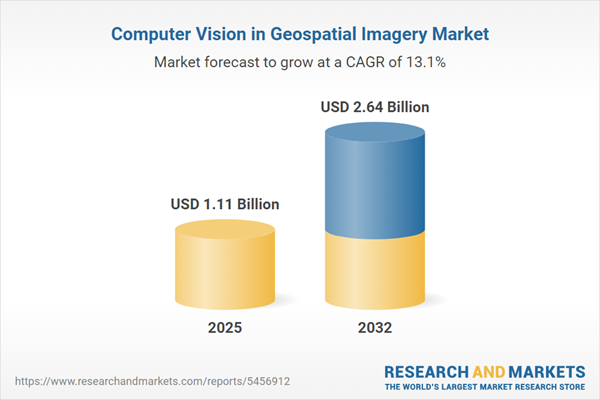Speak directly to the analyst to clarify any post sales queries you may have.
Computer vision in geospatial imagery equips enterprises with rapid access to spatial intelligence, accelerating informed decision-making and operational responses across multiple industries. As organizations increase their digital capabilities, integrating advanced spatial data analytics is becoming an essential focus for senior leaders seeking a strategic advantage.
Market Snapshot: Computer Vision in Geospatial Imagery Market Trends
The Computer Vision in Geospatial Imagery Market is growing globally, reflecting a robust expansion driven by increased enterprise adoption and technological advancement. In 2024, the market has achieved a value of USD 987.20 million and is projected to reach USD 1.11 billion in 2025, with a compound annual growth rate of 13.12% anticipated through 2032. This strong trajectory is shaped by the acceleration of digital transformation, the need for advanced spatial data solutions, and a shift toward data-centric organizations. The adoption is supported by advancements in machine learning, increasing volumes of high-resolution imagery, and expanded use in sectors such as defense, infrastructure, and environmental monitoring. The Americas lead with investments in operational modernization, while EMEA and Asia-Pacific regions target infrastructure upgrades and competitive positioning, creating a resilient foundation for global market evolution.
Scope & Segmentation of Computer Vision in Geospatial Imagery
This report offers senior decision-makers a strategic framework to evaluate the full value chain and identify opportunities for maximizing returns on spatial intelligence initiatives across diverse enterprise environments.
- Offering: Hardware investments include edge devices, unmanned aerial vehicles (UAVs), advanced imaging sensors, and ground stations. Software platforms provide integrated analytics, automated systems, and interoperability. Service options span technical support, consulting, system integration, and comprehensive data annotation to ensure effective data governance and operational efficiency.
- Application: Key segments comprise environmental surveillance, defense operations, agriculture monitoring, urban planning, disaster response, infrastructure review, land and resource assessment, and precision surveying, helping organizations to boost decision-making accuracy and adapt swiftly to changing regulatory and environmental conditions.
- Deployment Mode: Enterprises can select from cloud, hybrid, or on-premise deployment models, aligning solution implementation with needs related to compliance mandates, scalability, and operational strategy.
- Regions: Adoption patterns vary by geography. The Americas prioritize operational modernization; Europe, Middle East, and Africa (EMEA) focus on infrastructure renewal; and Asia-Pacific targets competitive adaptation, each responding to sectoral demands and investment climate.
- Leading Companies: Key providers include Maxar Technologies Inc, Airbus SE, Planet Labs PBC, Hexagon AB, L3Harris Technologies, Teledyne Technologies Incorporated, BlackSky Technology Inc, Orbital Insight Inc, Descartes Labs Inc, and Capella Space Corp, each bringing unique spatial product expertise to support enterprise requirements.
Key Takeaways for Senior Decision-Makers
- Integrating artificial intelligence with geospatial data strengthens spatial analysis and empowers leaders with actionable operational insights for higher productivity and strategic alignment.
- Flexible deployment models like edge computing and hybrid architectures help ensure analytics adaptability, operational continuity, and adherence to privacy controls in sensitive settings.
- Adoption of open standards and collaborative frameworks fosters interoperability, enabling scalable integration of spatial technologies within complex digital infrastructures.
- Robust data privacy protocols and secure access controls support regulatory compliance and protect valuable enterprise data as the regulatory landscape evolves.
- Strategic approaches differ globally: mature economies emphasize comprehensive spatial system adoption, while emerging markets focus on sustainability and risk mitigation through tailored geospatial applications.
Tariff Impact on Supply Chains and Operations
Recent tariff changes in the United States have led to increased hardware costs and additional supply chain complexities for computer vision in geospatial imagery projects. To navigate these shifts, organizations are strengthening relationships with local vendors, optimizing logistics, and reinforcing compliance systems, all of which support resilience as international trade dynamics evolve.
Methodology & Data Sources
This report is grounded in technical publications, regulatory reviews, exclusive expert interviews, and direct engagement with industry stakeholders, delivering a comprehensive and reliable resource tailored to executive needs in spatial intelligence.
Why This Report Matters
- Enables precise planning for technology investments and cultivates robust partnership networks, supporting the ongoing advancement of the geospatial imagery ecosystem.
- Facilitates benchmarking and accelerates transformation initiatives in line with the latest compliance requirements and regulatory frameworks.
- Drives operational efficiency and continuous improvement by helping organizations adopt advanced spatial workflows and adapt as market demands shift.
Conclusion
This report provides senior decision-makers with actionable intelligence for streamlined planning and strategic adaptation, supporting effective navigation of emerging developments in spatial intelligence technologies.
Additional Product Information:
- Purchase of this report includes 1 year online access with quarterly updates.
- This report can be updated on request. Please contact our Customer Experience team using the Ask a Question widget on our website.
Table of Contents
3. Executive Summary
4. Market Overview
7. Cumulative Impact of Artificial Intelligence 2025
Companies Mentioned
The companies profiled in this Computer Vision in Geospatial Imagery market report include:- Maxar Technologies Inc.
- Airbus SE
- Planet Labs PBC
- Hexagon AB
- L3Harris Technologies, Inc.
- Teledyne Technologies Incorporated
- BlackSky Technology Inc.
- Orbital Insight Inc.
- Descartes Labs, Inc.
- Capella Space Corp.
Table Information
| Report Attribute | Details |
|---|---|
| No. of Pages | 181 |
| Published | October 2025 |
| Forecast Period | 2025 - 2032 |
| Estimated Market Value ( USD | $ 1.11 Billion |
| Forecasted Market Value ( USD | $ 2.64 Billion |
| Compound Annual Growth Rate | 13.1% |
| Regions Covered | Global |
| No. of Companies Mentioned | 11 |









